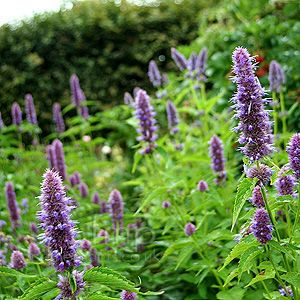Licorice mint, also known as anise hyssop (Agastache foeniculum), is a herbaceous perennial plant that belongs to the mint family (Lamiaceae). It is native to North America and is known for its aromatic leaves and beautiful flowers. Here are some of the uses and qualities of licorice mint plants:
- Culinary Use: Licorice mint has leaves with a sweet, licorice-like flavour and aroma. The leaves can be used fresh or dried to add a unique and pleasant taste to teas, salads, desserts, and savoury dishes. They can also be used as a garnish for drinks and cocktails.
- Medicinal Properties: Traditionally, licorice mint has been used in herbal medicine for its various health benefits. It is believed to have anti-inflammatory, antimicrobial, and antioxidant properties. The plant has been used to soothe sore throats, reduce respiratory issues, and aid in digestion.
- Aromatic Qualities: The leaves and flowers of licorice mint release a delightful fragrance, making it an excellent addition to potpourri, sachets, or herbal pillows. Simply crushing the leaves can release their pleasant aroma.
- Attractive to Pollinators: The beautiful flowers of licorice mint, which come in shades of purple, blue, or pink, are attractive to bees, butterflies, and other pollinators. It can be used in pollinator-friendly gardens to support beneficial insect populations.
- Ornamental Value: Apart from its culinary and medicinal uses, licorice mint also has ornamental value. It is an attractive plant with tall, slender stems and vibrant, showy flowers that can enhance the beauty of a garden or landscape.
- Drought Tolerance: Licorice mint is relatively drought-tolerant once established, making it suitable for regions with dry or arid climates. It can thrive in well-draining soils and requires little maintenance once it has developed a strong root system.
- Low-Maintenance: As a perennial, licorice mint comes back year after year, reducing the need for replanting. It is generally low-maintenance and can tolerate a range of soil conditions.
- Culinary Herb Garden: Licorice mint can be a valuable addition to a culinary herb garden due to its unique flavour and culinary versatility. It pairs well with various herbs and can be harvested for use throughout the growing season.
- Tea and Infusions: The leaves of licorice mint are commonly used to brew herbal teas and infusions, which are not only delicious but also provide potential health benefits.
- Companion Planting: Licorice mint is believed to have pest-repellent qualities, making it a suitable companion plant in vegetable gardens. It can help deter certain pests and attract beneficial insects.
Overall, licorice mint is a versatile and beneficial plant that can be used for culinary, medicinal, ornamental, and ecological purposes. Its sweet, licorice-like flavour and aromatic qualities make it an appealing addition to various settings, while its low-maintenance and drought-tolerant nature make it an attractive choice for gardeners seeking sustainable and multi-functional plants.
